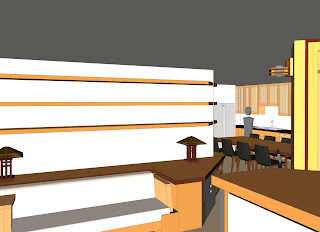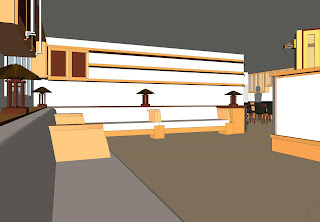If one understands the work of Frank Lloyd Wright not so
much in terms of style, but more the result of
of deeply and elaborately contrived methods for organizing
and sub-dividing space, there would seem
to be ample justification for
applying his design methods to situations where space is limited,
where every square foot must be made to contribute, or more
precisely with respect to Wright, every cubic foot must
perform in its service to form and function while acting
in unison with, being 'integrate' to the whole. Wright's
design methods equally emphasize creation of space with
characteristics of serenity, refuge and spaciousness, and so
in sum, seem well suited to the challenges faced in the design
of New York City apartments, whose residents must feel keenly
and sub-dividing space, there would seem
to be ample justification for
applying his design methods to situations where space is limited,
where every square foot must be made to contribute, or more
precisely with respect to Wright, every cubic foot must
perform in its service to form and function while acting
in unison with, being 'integrate' to the whole. Wright's
design methods equally emphasize creation of space with
characteristics of serenity, refuge and spaciousness, and so
in sum, seem well suited to the challenges faced in the design
of New York City apartments, whose residents must feel keenly
the need to get maximum use from limited and very
expensive space in the midst of a frequently
hectic alienating environment. And so one
might expect New York residential architecture
to constitute a veritable laboratory in the study and application
of Wrightian design strategies.
In fact, this is not at all the case.
On the contrary one notes how New York residential architecture
roughly divides into two antithetical style schools.
On one hand you have a neoclassical style, whose foremost
concern is to create a set of interior effects which convincingly
relay the message that the residents duly possess
upper class status. This has long been the intention
of neoclassical design, which emerged in tandem
with the nascent monarchies of Europe. These emerginng
monarchies following the Gothic period, revived Greco-Roman forms
and in particular the Imperial Roman style, as a means of
demonstrating both the fact of their possession of power and the
legitimacy of that possession - as a way of casting themselves as
the rightful heirs to the rule of the Roman empire which had lain
dormant for a thousand years after the fall. In brief monarchies
seized on the neoclassical style as a means to
so dazzle their subjects that they would view their rulers
as the just and deserving wielders of power.
On the other hand you have the minimalist or neo-Meisien style
whose sparse, spare interiors originated in the lean times of Europe
after the first world war when socialist architects sought to
create a scaled down, de-ornamented, working class architecture.
Any hint of ornament on a residence was considered
taboo as it might suggest an attempt by its inhabitants to claim
loftier social position and prestige. Being home to some of the
most expensive residential real-estate on the planet
New York City seems an unlikely spot to find much in the way of
minimalist architecture, much less find it thriving in multi-thousand
square feet, multi-million dollar digs. Perhaps the explanation
is to be found in the cover minimalism provides multimillionaires
and their loyal servants their architects. By using styles and forms
normally associated with working class housing, attention is shifted
away from the all too real fact of New York residential architects
creating residential architecture for a privileged class,
allowing its presentation to come more in terms of a
socially responsible, more environmentally conscious architecture.
Where one style seeks to dazzle, the other seeks only to bore.
I hasten to add I engage in this little bit of analysis
not at all with the intention so much of
mounting an attack but as a way of scrutinizing, of pulling the situation
out from the shadows in order to reveal clearly the heavy
burden these sorts of really political considerations
have put on architecture. And by political I merely mean
this inordinate concern for how something is perceived, judged,
interpreted, so on and so forth. My purpose is to
point out that the motive
forces operating in these two style schools, or what might be
described as the dialectic of pretense and
anti-pretense, have led us down a blind alley,
have hindered accomplishment of the much more important
task of aesthetic invention and creativity that
ought to be at the forefront of architecture.
Architecture needs now to move beyond the
present distractions of pretense and anti-pretense, or lately the hybrid
now more or less in vogue in the form of the irony and
oddity embodied in post modernism.
The time has come in which as Wright so
elegantly put it, "architecture has to be".
Architecture has both a functional and artistic component..
What Wright simply meant was that its artistic component
should recognize that art is merely emotion for emotions sake.
It should not try to dazzle, to make us envious, make us
wish we could live in such a place - what Joyce termed pornographic art,
it should not lecture us about morality, as for instance when
Adolf Loos says onrnament is a crime - what Joyce called
didactic art - rather it should move us to have a kind of
experience not otherwise available - what Joyce called
the sublime. I believe it is just this characteristic, this
contact with the sublime which one experiences directly,
viscerally in Wrights best spaces, that accounts for the
extraordinary popularity of his buildings, the near
sacred way in which they are revered, in which
they call forth their legions of pilgrims.
Wrights design methods are imminently suited
to planning New York apartments, from the smallest studio to
the grandest townhouse. As a case in point I have put together
a before and after design for a typical NYC two bedroom. Ive
deliberately chosen digs somewhat smaller than
what customarily gets the attention of architects, a
two bedroom listed for sale off Central Park West,
just to show how much Wrightian design techniques could do
for the less affluent - to show what a kind of Usonian equivalent
for apartments might look like.


















